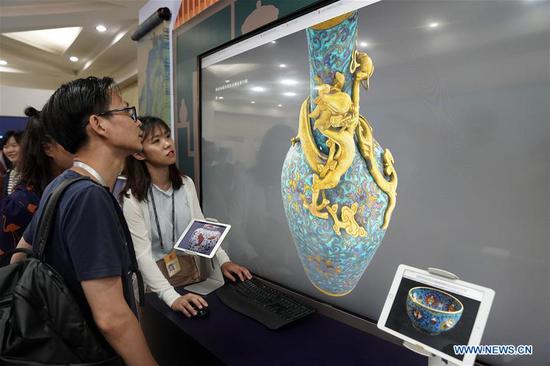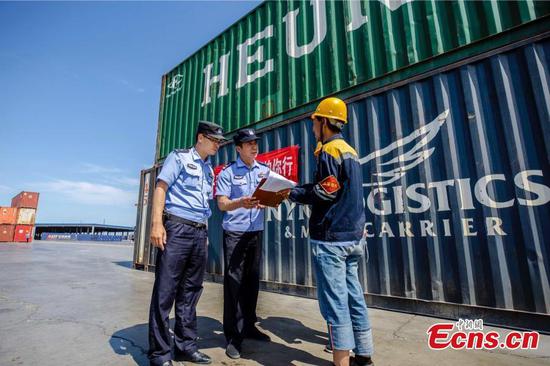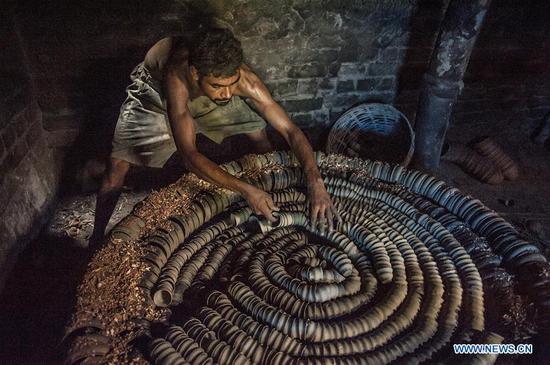
A cashier at a bank in Taiyuan, Shanxi province, counts renminbi notes. (Photo by Zhang Yun/China News Service)
China's banking and insurance regulator recently issued guidelines that require banking and insurance institutions to offer comprehensive financial solutions to companies in the upstream and downstream of a supply chain based on real business transactions, making a new effort to tighten regulation of supply-chain finance.
The guidelines, issued by the China Banking and Insurance Regulatory Commission, require banking and insurance institutions to stick to the principle of ensuring the truthfulness of transactions to prevent fabricated financing through falsified transactions, reported Caixin Media, a Beijing-based media group providing financial and business news.
The regulator reportedly stressed that banks should ensure that they acquire first-hand, original transaction data from the borrower and its partner that helps enhance its credit. Banks should also adhere to comprehensive risk surveillance by monitoring risks associated with not only the lead company in a supply chain, but also companies in the upstream and downstream of the supply chain, according to the CBIRC.
The guidelines were issued following quarrels between financial institutions and large online retailers JD and Suning.com Co over their roles in fraudulent fundraising by their suppliers, backed by accounts receivable from the online retailers. But both JD and Suning.com said they are unaware of the above mentioned financing activities.
Zeng Gang, deputy director of the National Institution for Finance and Development, said the biggest risk of supply-chain financing lies in the truthfulness of transactions based on which a bank makes a lending decision.
"How to prevent operational risk, such as collusion between financial officers of a core company with other businesses in the upstream and downstream of a supply chain to commit loan fraud, is a major problem to be solved by banks providing supply-chain finance solutions. Banks should repeatedly verify whether or not a transaction is real by improving business process management and reducing manual operational risk to the greatest extent with the use of financial technologies," he said.
In the guidelines, the regulator also encouraged banking and insurance institutions to embed new technologies, such as blockchain and the internet of things, into business transactions and use technologies including electronic fence and satellite positioning to remotely monitor the logistics and inventory of the borrowers.
China Zheshang Bank, a Hong Kong-listed national joint-stock commercial lender headquartered in Hangzhou, Zhejiang province, has used the blockchain technology during its exploration with supply chain finance.
Based on the creditworthiness of Zhejiang Rifa Textile Machinery Co, a manufacturer of spinning and weaving machines, CZBank granted lines of credit to Rifa's downstream small and medium clients to bridge the funding gap for their equipment purchases.
The financial innovation helped more than 100 private textile companies upgrade their equipment, increased Rifa's sales revenue by 300 million yuan ($43.6 million), and reduced the financial costs of its downstream enterprises by around 20 percent, according to CZBank.
Supply-chain finance is an important measure for banks to further support the real economy, which refers to the part of the economy that produces goods and services, and better serve small businesses. During the process, improvement of the legal environment, information infrastructure construction, technology adoption, and industry research are all essential factors for supply-chain finance risk management, said Zeng.
Having said that, it is still worth noting that banks ought to pay close attention to possible systemic risks associated with supply-chain finance, he added.
"As the risk of supply-chain finance relies heavily on the business conditions of core companies, banks should also strengthen forward-thinking research of a particular industry. Based on the results of studies, banks could set an upper limit on the line of credit and make decisions on when to develop supply chain finance, when to contain the business, and when to withdraw from it," he said.


















































